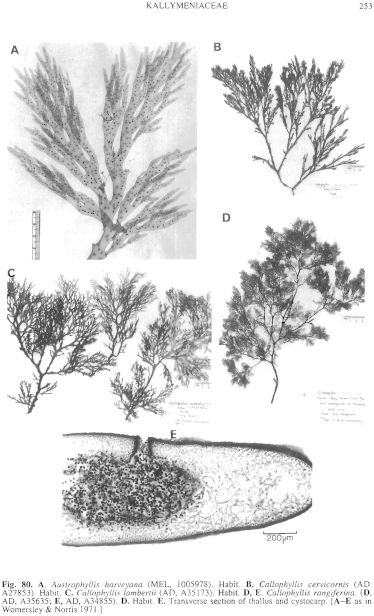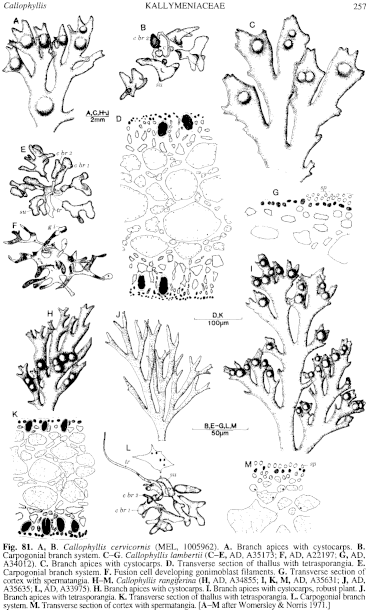|
|
|
|
|
|||||||||||
|
Electronic Flora of South Australia Species Fact Sheet
Phylum Rhodophyta – Class Florideophyceae – Order Gigartinales – Family Kallymeniaceae
Selected citations: Fuhrer et al. 1981: pl. 44.
Synonyms
Fucus rangiferinus Turner 1811: 114, pl. 183.
Callophyllis coccinea (Harvey in Hooker & Harvey) Kützing 1849: 746; 1867: 27, pl. 92d, e. J. Agardh 1851: 301; 1876: 234; 1901: 19. Harvey 1855a: 555; 1860a: 324; 1863, synop.: xliii. Lucas & Perrin 1947: 159, fig. 31. Womersley 1950: 168. Womersley & Norris 1971: 35, figs 65–71, 102–104.
Rhodymenia (Callophyllis) coccinea Harvey in Hooker & Harvey 1847: 405.
Sphaerococcus australis Harvey 1844: 445.
Callophyllis coccinea var. corymbosa J. Agardh 1876: 234.
Callophyllis carnea J. Agardh 1849: 87; 1851: 301; 1885: 37; 1901: 19. Harvey 1863, synop.: xliii.
C. coccinea var. carnea (J. Agardh) J. Agardh 1876: 234.
Callophyllis hookeri Kützing 1867: 26, pl. 90a, b.
Callophyllis microcarpa Zanardini 1874: 501.
Callophyllis gigartinoides J. Agardh 1896: 73; 1901: 19. Kylin 1931: 33, pl. 19 fig 47.
Callophyllis lingulata J. Agardh 1901: 21.
Thallus (Fig. 80D) medium to dark red, 5–20 (–25) cm high, with branches essentially in one plane but often displaced, with one to several axes profusely branched in an irregularly lateral to flabellate or subdichotomous manner, usually with much-branched clusters of slender lateral branches in the upper parts; lower axes (2–) 3–6 mm broad and in old plants often denuded and marginally proliferous if regrowth occurs, most branches 1–3 mm broad, tapering fairly evenly (or more abruptly in corymbose forms) to slender, lanceolate, usually acute apices (Fig. 81H–J) less than 0.5 mm broad close to the apex and usually less than 1 mm broad for several millimetres back from the apex; all axes and branches normally sub-branched or with small outgrowths or proliferations at intervals of less than 0.5 (–1) cm; substance cartilaginous, slightly to moderately strongly adhering to paper on drying. Holdfast discoid, 2–5 mm across; epilithic. Structure. Thallus (Fig. 81K) usually 200–300 µm thick near apices, 400–500 µm below and 700–800 (–1000) µm thick near the base, consisting of a medulla of large, ovoid, and usually thick-walled cells, irregularly arranged and with intermixed small ovoid to elongate cells; cortex of several layers of irregularly ovoid cells, smaller outwards, with the outermost cells in surface view closely packed, isodiametric to ovoid and 3–4 µm across.
Reproduction: Sexual thalli dioecious. Carpogonial branch systems (Fig. 81L) formed in the outer medulla, 60–100 µm across when mature, monocarpogonial with the supporting cell, first cell of the carpogonial branch, and 2–3 subsidiary cells all much lobed and the second cell of the carpogonial branch elongate-ovoid and simple or slightly lobed. Fusion cell 60–90 µm across, producing gonimoblast filaments. Carposporophyte with numerous groups of subspherical to ovoid carposporangia (12–22 µm in diameter) separated by gonimoblast filaments; cystocarps (Figs 80E, 81H, I) 400–700 µm in diameter, scarcely to moderately swollen and sometimes distinctly protuberant, becoming ostiolate (occasionally with a projecting ostiole in well-developed protuberant cystocarps), situated a few millimetres from the apices. Male thalli with spermatangia (Fig. 81M) cut off from the outer cortical cells, 1.5–2 µm across in surface view, covering young branches and occasionally forming indefinite sori.
Tetrasporangia (Fig. 81K) scattered in the outer cortex, cruciately divided, 30–40 µm long by 17–21 µm broad, occasionally aggregated in the form of sori.
Type from Georgetown, Tas. (Gunn 1279); holotype in TCD.
Selected specimens: Champion Bay, W. Aust. (Gale, 1880; MEL, 1006435). Esperance, W. Aust., drift (Firman, Dec. 1951; AD, A18926). Elliston Bay, S. Aust., 6 m deep near entrance (Shepherd, 24.x.1969; AD, A34793). Topgallant I., S. Aust., 27 m deep (Turner, 29.iii.1982; AD, A53056). Pearson I., S. Aust., 5 m deep (Shepherd, 8.i.1969; AD, A33975). Seal Bay, Kangaroo I., S. Aust., drift (Womersley, 21.i.1965; AD, A28659). Port Elliot, S. Aust., drift (Womersley, 17.x.1948; AD, A9360). Margaret Brock Reef, Cape Jaffa, S. Aust., 10 m deep (Lewis, 15.ii.1974; AD, A45026). 1.3 km off Cape Northumberland, S. Aust., 14 m deep (Shepherd, 13.iii.1975; AD, A46168). Point Lonsdale, Vic., drift (Womersley, 10.xii.1969; AD, A34855). Walkerville, Vic., drift (Sinkora A2255, 2.iii.1976; AD, A48513). Gabo 1., Vic., 24 m deep (Shepherd, 14.ii.1973; AD, A43309). Guyton Point, Robbins I., Tas., drift (Wollaston & Mitchell, 23.ii.1964; AD, A27716). Low Head, Tas., (Perrin, June 1943; AD, A8957). Marion Bay, Tas., 6 m deep (Shepherd, 13.ii.1970; AD, A35631, A35635). Lady Bay, Southport, Tas., 3–5 m deep (Brown & Womersley, 28.x.1982; AD, A56538).
Distribution: Recorded from the Chatham Is and New Zealand by Laing (1927, p. 152; 1939, p. 146).
Champion Bay, W. Aust., to Tathra, N.S.W. (Millar & Kraft 1993, p. 20) and around Tasmania.
Taxonomic notes: The numerous synonyms of this variable species were discussed by Womersley & Norris (1971, p. 37), and the earliest name was clarified by Womersley (1973, p. 256). While many specimens appear distinct from the broader C. lambertii, others appear to be intergrades and detailed studies may show it is difficult to distinguish these two species. Relationships with C. cervicornis are also not always clear.
References:
AGARDH, J.G. (1849). Algologiska bidrag. Öfvers. K. Svenska Vetensk. Akad. Rh-h. 6(3), 79–89.
AGARDH, J.G. (1851). Species Genera et Ordines Algarum. Vol. 2, Part 1, 1–336 + index. (Gleerup: Lund.)
AGARDH, J.G. (1876). Species Genera et Ordines Algarum. Vol. 3, Part 1 - Epicrisis systematis Floridearum, pp. i-vii, 1–724. (Weigel: Leipzig.)
AGARDH, J.G. (1885). Till algemes systematik. VII. Florideae. Acta Univ. lund. 21, 1–120, Plate 1.
AGARDH, J.G. (1896). Analecta Algologica. Cont. III. Acta Univ. lund. 32, 1–140, Plate 1.
AGARDH, J.G. (1901). Species Genera et Ordines Algarum. Vol. 3, Part 4, pp. 1–149. (Gleerup: Lund.)
FUHRER, B., CHRISTIANSON, I.G., CLAYTON, M.N. & ALLENDER, B.M. (1981). Seaweeds of Australia. (Reed: Sydney.)
HARVEY, W.H. (1844). Algae of Tasmania. Lond. J. Bot. 3, 428–454.
HARVEY, W.H. (1855a). Some account of the marine botany of the colony of Western Australia. Trans. R. Ir. Acad. 22, 525–566.
HARVEY, W.H. (1860a). Algae. In Hooker, J.D., The Botany of the Antarctic Voyage. 111. Flora Tasmaniae. Vol. II, pp. 321–343, Plates 185–196.
HARVEY, W.H. (1863). Phycologia Australica. Vol. 5, Plates 241–300, synop., pp. i-lxxiii. (Reeve: London.)
HOOKER, J.D. & HARVEY, W.H. (1847). Algae Tasmanicae. Lond. J. Bot. 6, 397–417.
KÜTZING, F.T. (1849). Species Algarum. (Leipzig.)
KÜTZING, F.T. (1867). Tabulae Phycologicae. Vol. 17. (Nordhausen.)
KYLIN, H. (1931). Die Florideenordnung Rhodymeniales. Lunds Univ. Årsskr. N.F. Avd. 2, 27 (11), 1–48, Plates 1–20.
LAING, R.M. (1927). A reference list of New Zealand marine algae. Trans. Proc. N.Z. Inst. 57, 126–185.
LAING, R.M. (1939). New Zealand Seaweeds - Reference list No. H. The Rhodophyceae -Part A. (Bangiales, Némalionales, Cryptonemiales, and Gigartinales). Trans. Proc. R. Soc. N.Z. 69, 134–164.
LUCAS, A.H.S. & PERRIN, F. (1947). The Seaweeds of South Australia. Part 2. The Red Seaweeds. (Govt Printer: Adelaide.)
MILLAR, A.J.K. & KRAFT, G.T. (1993). Catalogue of Marine and Freshwater Red Algae (Rhodophyta) of New South Wales, including Lord Howe Island, South-western Pacific. Aust. Syst. Bot. 6, 1–90.
TURNER, D. (1811). Fuci sive Plantarum Fucorum Generi a Botanicis Ascriptarum Icones Descriptiones et Historia. Vol. 3, pp. 1–148, Plates 135–196. (London.)
WOMERSLEY, H.B.S. & NORRIS, R.E. (1971). The morphology and taxonomy of Australian Kallymeniaceae (Rhodophyta). Aust. J. Bot. Suppl. 2, pp. 1–62.
WOMERSLEY, H.B.S. (1950). The marine algae of Kangaroo Island. III. List of Species 1. Trans. R. Soc. S. Aust. 73, 137–197.
WOMERSLEY, H.B.S. (1973). Further studies on Australian Kallymeniaceae (Rhodophyta). Trans. R. Soc. S. Aust. 97, 253–256.
ZANARDINI, J. (1874). Phyceae Australicae novae vel minus cognitae. Flora (Regensburg) 57, 486–490, 497–505.
The Marine Benthic Flora of Southern Australia Part IIIA complete list of references.
Publication:
Womersley, H.B.S. (14 January, 1994)
The Marine Benthic Flora of Southern Australia
Rhodophyta. Part IIIA, Bangiophyceae and Florideophyceae (to Gigartinales)
Reproduced with permission from The Marine Benthic Flora of Southern Australia Part IIIA 1994, by H.B.S. Womersley. Australian Biological Resources Study, Canberra. Copyright Commonwealth of Australia.
Illustrations in Womersley Part IIIA, 1994: FIGS 80D, E, 81 H–M.

Figure 80 enlarge
Fig. 80. A. Austrophyllis harveyana (MEL, 1005978). Habit. B. Callophyllis cervicornis (AD, A27853). Habit. C. Callophyllis lambertii (AD, A35173). Habit. D, E. Callophyllis rangiferina. (D, AD, A35635; E, AD, A34855). D. Habit. E. Transverse section of thallus and cystocarp. [A–E as in Womersley & Norris 1971.]

Figure 81 enlarge
Fig. 81. A, B. Callophyllis cervicornis (MEL, 1005962). A. Branch apices with cystocarps. B. Carpogonial branch system. C–G. Callophyllis lambertii (C–E, AD, A35173; F, AD, A22197; G, AD, A34012). C. Branch apices with cystocarps. D. Transverse section of thallus with tetrasporangia. E. Carpogonial branch system. F. Fusion cell developing gonimoblast filaments. G. Transverse section of cortex with spermatangia. H–M. Callophyllis rangiferina (H, AD, A34855; I, K, M, AD, A35631; J, AD, A35635; L, AD, A33975). H. Branch apices with cystocarps. I. Branch apices with cystocarps, robust plant. J. Branch apices with tetrasporangia. K. Transverse section of thallus with tetrasporangia. L. Carpogonial branch system. M. Transverse section of cortex with spermatangia. [A–M after Womersley & Norris 1971.]

|
Email Contact: State Herbarium of South Australia |

|